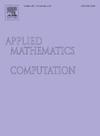多重网络中疫苗信息为阴性的两株疾病传播动力学及疫苗接种
IF 3.4
2区 数学
Q1 MATHEMATICS, APPLIED
引用次数: 0
摘要
在疾病传播过程中,病毒可能发生变异,出现新的毒株。这导致疫苗对原菌株的免疫效果降低,接种疫苗的个体也可能被感染,从而导致疫苗负面信息的产生和传播。然而,多毒株疾病与阴性疫苗信息的耦合动力学尚未得到全面的研究。本文同时考虑疾病的原株和突变株,并在繁殖过程中引入疫苗接种行为,将经典的易感-感染-易感(SIS)模型扩展为易感、接种、原株感染、突变株感染和恢复五种状态。在此基础上,提出了一种描述负疫苗信息与两株疫病耦合传播动态的双层网络模型,并利用微观马尔可夫链法(MMCA)推导出了两株疫病的流行爆发阈值。随后,将MMCA计算结果与蒙特卡罗(Monte-Carlo)模拟结果进行了比较,验证了前者的正确性。最后,通过相图和时间历史曲线对疫情阈值和疫苗接种成本、疫苗有效性和疫苗阴性信息等信息-疾病传播动态进行参数化研究。本研究表明,在突变株感染率较低的情况下,降低疫苗接种成本和加强疫苗的正面宣传可以有效地防止疾病的传播。如果感染率较大,有效的措施是开发针对突变株的特异性疫苗,以提高疫苗接种效果。这些发现为当局采取适当的疾病预防措施提供了有价值的战略。本文章由计算机程序翻译,如有差异,请以英文原文为准。
Dynamics of two-strain disease transmission with negative vaccine information and vaccination on multiplex networks
During the disease transmission, the virus may mutate and novel strains appear. That causes the reduction of the immune effect of the vaccine against the original strain, and the vaccinated individuals may also be infected, which would lead to the generation and dissemination of negative vaccine information. However, the coupled dynamics of multi-strain disease and negative vaccine information has not yet been comprehensively investigated. In this paper, we consider both the original and mutant strains of the disease and introduce vaccination behavior in the propagation process to expand the classic susceptible-infectious-susceptible (SIS) model into five states: susceptible, vaccinated, infected by original strain, infected by mutant strain and recovered. Then, a two-layer network model is proposed to describe the coupled propagation dynamics of the negative vaccine information and the two-strain disease, and the epidemic outbreak thresholds of the two-strain disease are derived by using the Microscopic Markov Chain Approach (MMCA). Subsequently, the numerical results derived from the MMCA are compared with those from Monte-Carlo (MC) simulation to validate the correctness of the former. Finally, the phase diagrams and time history curves are presented to conduct parametric studies on the epidemic thresholds and information-disease transmission dynamics, such as the vaccination cost, vaccine effectiveness and the negative vaccine information. This research demonstrates that reducing the vaccination cost and enhancing the positive publicity of vaccine can effectively prevent the disease spreading when the infection rate of the mutant strain is low. If this infection rate is large, the effective measure is developing specific vaccines against the mutant strain to improve the vaccination efficacy. Those findings provide valuable strategies for the authorities to make appropriate disease prevention measures.
求助全文
通过发布文献求助,成功后即可免费获取论文全文。
去求助
来源期刊
CiteScore
7.90
自引率
10.00%
发文量
755
审稿时长
36 days
期刊介绍:
Applied Mathematics and Computation addresses work at the interface between applied mathematics, numerical computation, and applications of systems – oriented ideas to the physical, biological, social, and behavioral sciences, and emphasizes papers of a computational nature focusing on new algorithms, their analysis and numerical results.
In addition to presenting research papers, Applied Mathematics and Computation publishes review articles and single–topics issues.

 求助内容:
求助内容: 应助结果提醒方式:
应助结果提醒方式:


